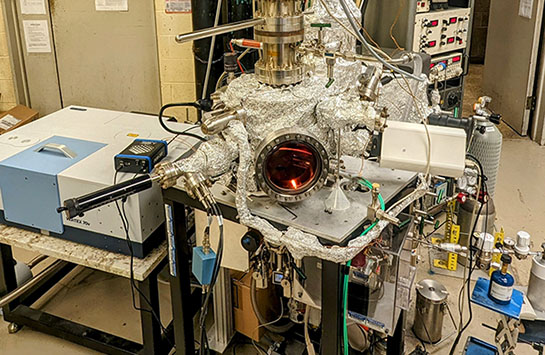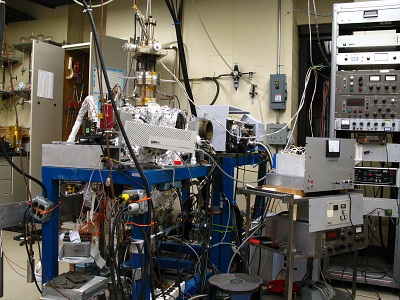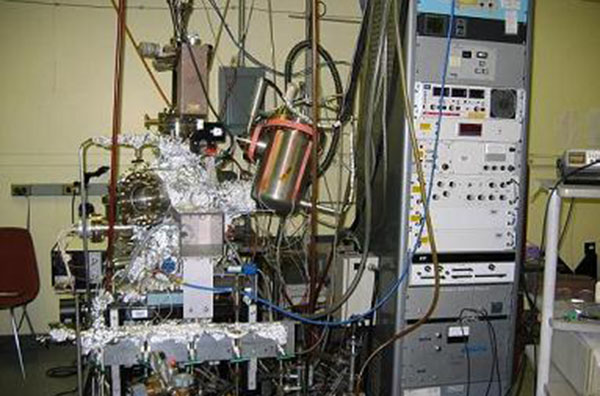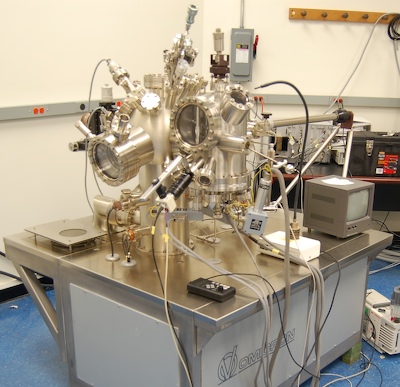UHV - Ambient Pressure RAIRS System Heading link

Our ambient pressure RAIRS system contains two separate chambers for low and high pressure analysis. The main chamber is a typical UHV analysis chamber equipped with a quadrupole mass spectrometer (Prisma QMS200 from Pfeiffer), and a combined reverse-view low energy electron diffraction (LEED)- Auger electron spectrometer (AES) system from LK Technologies. The LEED (Series RVL2000) and AES (CMA2000) instruments share a common electron gun. The ambient pressure IR cell is located underneath the main chamber. It is coupled to a Bruker Vertex 70v FTIR; when performing an ambient pressure experiment, the crystal is passed through a differentially pumped sliding seal system into the high pressure cell. With the crystal at the IR focus, the sample probe seals off the upper UHV chamber from the high pressure IR cell. The low pressure in the main chamber is maintained by a turbo pump (Pfeiffer PM P02825), a titanium sublimation pump (Duniway TSP-275-00), and an ion pump (Varian 9192641M001). For the ambient pressure RAIRS studies, the polarization dependence of the interaction of infrared radiation with metal surfaces is used to distinguish between IR absorption peaks from gas-phase molecules and from adsorbed molecules. Two types of polarized IR experiments are performed. In the first type, termed polarization dependent (PD) RAIRS, experiments are first performed with s-polarized light, which is sensitive only to gas-phase molecules. The experiment is then repeated under exactly the same conditions with p-polarized light, which is sensitive both to adsorbed and to gas-phase molecules. By subtracting the s-polarized spectrum from the p-polarized spectrum, a spectrum of only the surface species is obtained. An alternative way to obtain the same information is through the technique of polarization modulation RAIRS using a photoelastic modulator. Each method has its advantages and disadvantages and both PD-RAIRS and PM-RAIRS experiments are performed with this apparatus.
UHV RAIRS System Heading link

This chamber is equipped with an FTIR (Bruker IFS-66v/s) for RAIRS studies, a quadrupole mass spectrometer (Hiden HAL 201/3F) interfaced to a personal computer for temperature programmed desorption (TPD) studies, a single-pass cylindrical mirror analyzer (Physical Electronics Model no. 10-155), and LEED optics (Physical Electronics 15-180). It is pumped with a turbo-molecular pump (Leybold-Heraeus TMP 360). It has all of the ancillary valves, vacuum gauges, sample manipulator, gas doser, sputter ion gun, etc., needed for surface science studies of reactive chemistry on transition metal surfaces.
RAIR-XPS System Heading link

In addition to a dedicated FTIR (Mattson RS-10,000) for RAIRS studies, this chamber is equipped with reverse-view LEED optics (Princeton Research Instruments RVL 8-120), a quadrupole mass spectrometer (UTI Instruments 100C) that is fully computer controlled for multiplexed TPD studies, and a hemispherical electron energy analyzer (VG Scientific CLAM 2) and a dual Mg/Al anode X-ray source (VG Scientific) for XPS studies. The chamber is pumped by a turbo-molecular pump (Balzers TMP 520).
Scanning Tunneling Microscopy System Heading link

Our group has a variable temperature UHV Scanning Probe Microscopy system (Omicron Nanotechnology GmbH ). This is a stand-alone instrument equipped with all of the pumps, valves, gauges, etc., needed for independent operation. It is equipped with reverse view LEED optics and an electron beam metal evaporator. The sample is introduced through a load lock. For sample preparation and LEED studies, the sample is mounted on a standard XYZ manipulator. It is transferred in UHV from this manipulator to the STM stage via a wobble stick. This STM system is located in a first-floor laboratory with low building vibrations. This system uses Matrix control electronics and corresponding software, version 4.3.0.